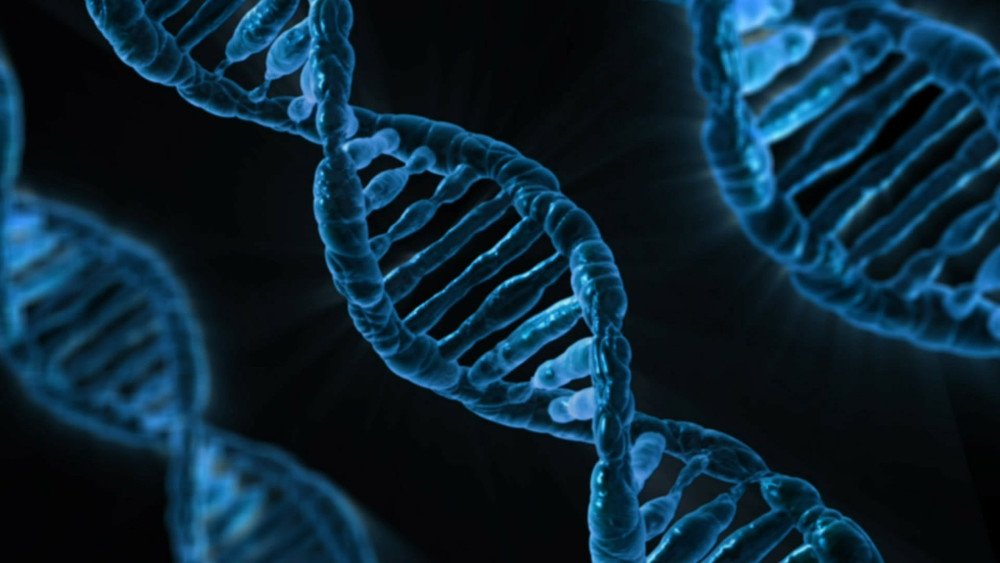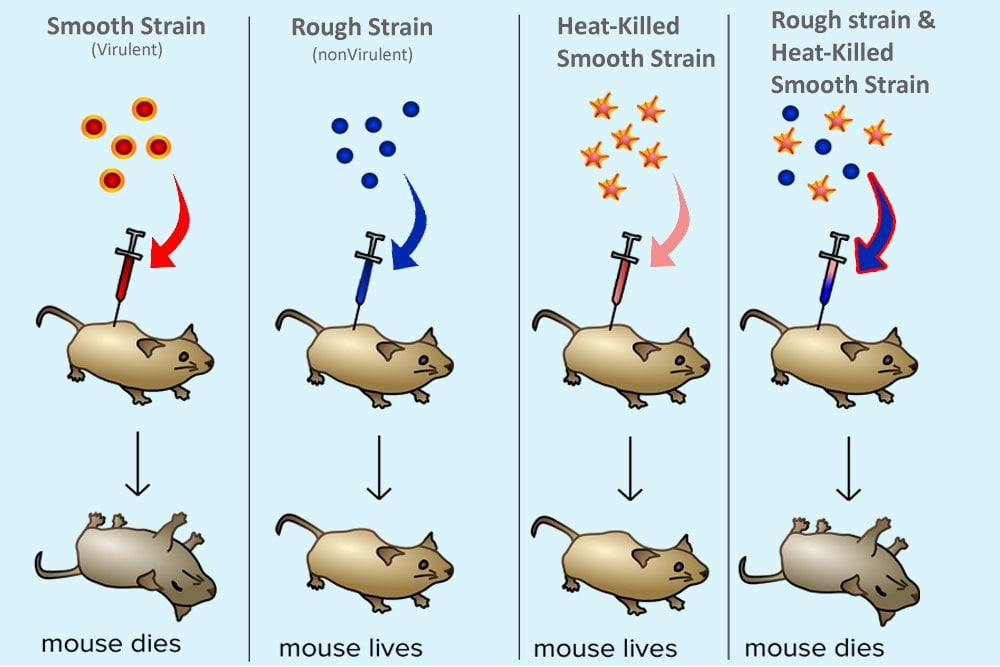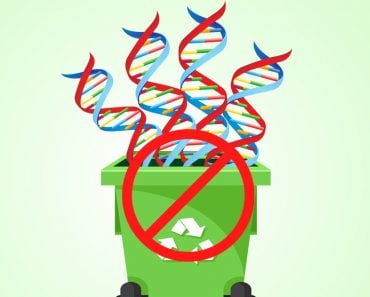Table of Contents (click to expand)
Three seminal experiments proved, without doubt, that DNA was the genetic material, and not proteins. These experiments were the Griffith experiment, Avery, MacLeod, and McCarthy Experiment, and finally the Hershey-Chase Experiment.
DNA is the fundamental component of our being. The human body is merely the carrier for this genetic material, passing it down from generation to generation. Our purpose is to ensure the survival of the species. Humans are to DNA like a fruit is to a seed. We are just an outer covering to ensure the safe passage and protection of the source code of our existence through time. Makes you feel pretty useless, doesn’t it?
However, that’s not what I want you to focus on. The main focus is, how did we discover that DNA is the carrier of information? How did we determine that it wasn’t something else, like proteins? After all, proteins are also present in every cell.
For a long time this debate had been going on. Even after Gregor Mendel formed the 3 laws of inheritance, it wasn’t accepted by the scientific community for 45 years. The reason? There was no concept of DNA or genes being the information carriers! The whole debate was finally put to rest by 3 main experiments carried out by independent researchers, which formed the basis of all our evolutionary and molecular biology studies.

Recommended Video for you:
Griffith Experiment
The first step was taken by Frederick Griffith in the year 1928. He was a bacteriologist who focused on epidemiology. Griffith was studying how Streptococcus pneumoniae caused an infection. He was working with 2 strains of the bacteria called the S and R strains. S strain organisms, when cultured in the lab, gave rise to bacterial colonies with a smooth appearance. This was due to a shiny, polysaccharide coat, which is supposed to be their virulence factor. A virulence factor is any quality or factor of a pathogen that helps it in achieving its goal – causing a disease! The other strain was the R strain. This strain gave rise to colonies that didn’t possess the polysaccharide coat, and therefore had a ‘rough’ appearance. Therefore, the S strain was virulent and the R strain was avirulent.
Griffith took 4 mice and injected them with different solutions. The first one was injected with the S strain organisms; the second one was injected with the R strain organisms; the third mouse was injected with heat-killed S strain organisms; and the last one was injected with a mixture of heat-killed S strain and live R strain organisms. The result? The first and fourth mice died due to the infection, while the second and third mice survived. When he extracted the infectious agent from the dead mice, in both cases, he found S strain organisms.

Let’s break it down. The first 2 mice showed that S strain is the virulent strain, while the R strain is avirulent. The third mouse proved that heat-killed S strain organisms cannot cause an infection. Now here is where it gets interesting. The death of the 4th mouse, and the retrieval of live S strain organisms showed that, somehow, the heat-killed S strain organisms had caused the transformation of live R strain organisms to live S strain organisms.
This was called the transformation experiment…not particularly creative in the naming department.
Avery, Macleod And McCarty Experiment
While Griffith’s experiment had provided a surprising result, it wasn’t clear as to what component of the dead S strain bacteria were responsible for the transformation. 16 years later, in 1944, Oswald Avery, Colin Macleod and MacLynn McCarty solved this puzzle.
They worked with a batch of heat-killed S strain bacteria. They divided it into 5 batches. In the first batch, they destroyed the polysaccharide coat of the bacteria; in the second batch they destroyed its lipid content; they destroyed the RNA of the bacteria in the third batch; with the fourth batch, they destroyed the proteins; and in the last batch, they destroyed the DNA. Each of these batches was individually mixed with live R strain bacteria and injected into individual mice.
From all 5 mice, all of them died except the last mouse. From all the dead mice, live S strain bacteria was retrieved. This experiment clearly proved that when the DNA of the S strain bacteria were destroyed, they lost the ability to transform the R strain bacteria into live S strain ones. When other components, such as the polysaccharide coat, lipid, RNA or protein were destroyed, transformation still took place. Although the polysaccharide coat was a virulent factor, it wasn’t responsible for the transfer of the genetic matter.

Hershey And Chase Experiment
Even after the compelling evidence provided by the Avery, Macleod and McCarty experiment, there were still a few skeptics out there who weren’t convinced. The debate still raged between proteins and DNA. However, the Hershey – Chase experiment permanently put an end to this long-standing debate.
Alfred Hershey and Martha Chase in 1952, performed an experiment that proved, without a doubt, that DNA was the carrier of information. For their experiment, they employed the use of the bacteriophage T2. A bacteriophage is a virus that only infects bacteria. This particular virus infects Escherichia coli. T2 had a simple structure that consisted of just 2 components – an outer protein casing and the inner DNA. Hershey and Chase took 2 different samples of T2. They grew one sample with 32P, which is the radioactive isotope of phosphorus, and the other sample was grown with 35S, the radioactive isotope of sulphur!
The protein coat has sulphur and no phosphorus, while the DNA material has phosphorus but no sulphur. Thus, the 2 samples were labelled with 2 different radioactive isotopes.
The viruses were then allowed to infect the E. coli. Once the infection was done, the experimental solution was subjected to blending and centrifugation. The former removed the ghost shells, or empty shells of the virus from the body of the bacteria. The latter separated the bacteria from everything else. The bacterial solution and the supernatant were then checked for their radioactivity.

In the first sample, where 32P was used, the bacterial solution showed radioactivity, whereas the supernatant barely had any radioactivity. In the sample where 35S was used, the bacterial solution didn’t show any radioactivity, but the supernatant did.
This experiment clearly showed that DNA was transferred from the phage to the bacteria, thus establishing its place as the fundamental carrier of genetic information.
Until the final experiment performed by Hershey and Chase, DNA was thought to be a rather simple and boring molecule. It wasn’t considered structured enough to perform such a complicated and extremely important function. However, after this experiment, scientists started paying much more attention to DNA, leading us to where we are in research today!












